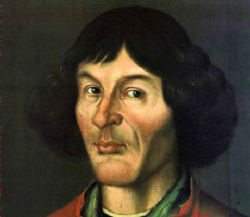Copernicus (1473–1543)


Nicolas Copernicus was a Polish mathematician and astronomer who served as Canon (an administrative position) for the church in Frauenberg. In the early 1500s he developed a sun-centered model that was the first real challenge to the long accepted model of Aristotle and Ptolemy. His major work was called Revolutions of the Celestial Spheres which was published just before his death in 1543. A Lutheran Minister Andrew Osiander handled the publication and inserted a preface without Copernicus' knowledge. In this preface he wrote that Copernicus was merely offering a hypothesis, not a true account of the workings of the heavens. Although this clearly did not represent Copernicus' viewpoint, it probably protected this work from close scrutiny by the church.
Copernicus' model offered the advantages that it didn't need epicycles in order to produce retrograde movement and it didn't need an equant point in order to produce non-uniform motion. However, epicycles were needed in order to obtain accurate predictions. The accuracy of his model with epicycles was good, but it was no better than Ptolemy's model. As far as complexity, Copernicus' model (including epicycles) was at least as complex as Ptolemy's model. Figure 5 shows Copernicus' model for Mars. The models for Jupiter and Saturn were similar to that of Mars, but the models for Venus and Mercury were even more complex.

In this model Mars follows a circular path around the point A. The point A follows a circular path around the point B. The point B also moves, but always stays in the same position relative to the point C. The point C is the center of the circular path followed by the Earth (not shown). C follows a circular path around the point D which in turn follows a circular path around the Sun. As with Ptolemy's model, Copernicus assumed that the points moved around their circular paths at a constant speed. He also assumed that the earth rotates about its axis producing the daily changes.
The Copernicus model had a simpler explanation for retrograde motion. Let us take Mars as an example. Mar's orbit is farther from the sun than Earth's orbit and it takes about two years for a complete rotation. Thus, the Earth moves faster and passes Mars about every two years. It is not hard to verify that retrograde motion of mars as seen from the earth happens during this passing. In addition mars will seem brighter during this retrograde motion since they are closest at this time.
All of the ancient models were committed to circular motion at constant velocity. Ptolemy was only able to obtain constant velocity by introducing an equant point. Copernicus considered that his greatest contribution was the elimination of the equant. His model also had a natural explanation for why Mercury and Venus always appeared near the sun. In the Copernican model the orbits of Mercury and Venus were closer to the sun than the Earth's orbit.
In the years that followed, a number of astronomers used Copernicus' model to make predictions. However, most viewed his model as a computational tool and not a representation of reality. The common sense arguments of Aristotle still seemed to support a fixed Earth. As we will see in the next section, it was Galileo who began to challenge many of the long held Aristotelian assumptions and revived interest in the Copernicus model.
+++++